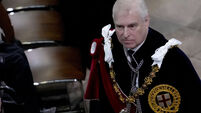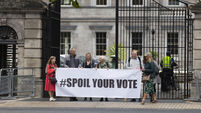The new all-inclusive GAA knows how to win young hearts and minds
There was plenty of cribbing before last Saturday evening’s start to the 125th birthday celebrations of the association because of the cost of the fireworks and lighting display and other associated events at the Croke Park national football league match between Dublin and Tyrone.
The critics were silenced by the pyrotechnic display and all of the 72,000 people in the stadium on that cold night were enthralled by what they saw, as was the TV audience on Setanta. Even better, they enjoyed a cracking game of football beforehand.
The crowd had chosen to pay for tickets at up to €20 compared to a normal maximum price of €15 and the additional money was used to pay for the celebrations. I doubt if anyone there considered it money badly spent.
Hopefully, the GAA will not be dissuaded by the pre-match criticism from investing in other events throughout the year to showcase its games and to attract what it rather quaintly calls “patrons” to them.
The GAA has prospered in good times and bad, mainly because of its deep-rootedness in the Irish psyche but has shown itself also to be very welcoming to newcomers to the country in recent years.
Having matured wonderfully as a broadminded and inclusive organisation in recent years — the neighbourly opening of Croke Park to rugby and soccer internationals while Lansdowne Road is being redeveloped is a perfect example of this — it has expanded its appeal beyond the traditional GAA community.
If this spirit of openness is maintained, then the GAA will not just keep its own following but continue to attract even greater numbers of those who play other sports, such as rugby and soccer.
To this end its network of clubs throughout the country is going to play a very important part in maintaining community and society spirit over the next few years. The Government’s quietly taken decision to abandon capital support for sports projects throughout the country will hit local ambitions within the GAA but fortunately many clubs had catered well for their needs during the boom years and will benefit from that investment now.
Not that the organisation will be without problems, caused by circumstances beyond its control.
The GAA, both at inter-county and club level, was one of the beneficiaries of the disappearance of emigration during the Celtic Tiger era. So-called weaker counties suddenly had a better selection of players available to them if only for the reason that they did not have to go abroad for work.
Clubs thrived and had few of the problems of old of fielding teams. Unfortunately, that is no longer the case. We won’t be worrying too much about young players going for trials with Aussie Rules teams; instead they’ll be going for jobs and may not be coming back.
In these circumstances it is important that the GAA does all it can to keep attendance numbers up at its matches during 2009. It is notable, unfortunately, that the average attendance at all of the weekend’s other national league matches outside of Croke Park has been estimated at just 3,200.
The weather is rotten at this time of year, admittedly, and some counties are guilty of not taking the league as seriously as they might — not picking anything like full-strength teams for example — but a disappointing trend of reduced attendance emerged during last season’s football championship.
It wasn’t just at the provincial championship stages but during the qualifiers, too. In hurling several championship matches attracted very disappointing crowds.
It should be remembered that during the 1980s there were some miserably small crowds at some big games, as the recession bit. There were all-Ireland semi-finals in Croke Park that attracted crowds of less than 10,000.
Last year’s atmosphere at the Cork-Kerry football semi-final replay was made better by the full stadium created by the presence of Tyrone and Wexford fans for the second semi-final.
People simply couldn’t afford the cost of tickets and travel, especially if families were going. Travel is expensive again and while ticket prices did not rise last year, there is an argument that they may have to be reduced quickly.
Croke Park, in particular, is much better suited to full crowds and double-headed fixtures may be needed on occasions.
There may be a reluctance to reduce prices because there are significant costs to be met paying for ground redevelopments, funding the cost of preparing teams and distributing money to clubs, but the GAA should take the Ryanair approach.
They should price tickets as cheaply as possible to try to fill grounds if at all possible. This year, above all, they should try to attract bigger crowds.
In fairness, the GAA is excellent already at making family tickets available at a reasonable cost. Two of the most enjoyable days of the year for me last year involved bringing my three young girls to the Cork and Kerry football semi-finals, costing just €5 each for their tickets. I reckon they’re hooked for life on going to Croke Park because of their excitement at being part of the atmosphere as much as what they saw on the pitch.
The number of young children I saw at the Ulster final in Clones between Fermanagh and Armagh was really encouraging: amid all the drama of the drawn game I imagine that many more children were hooked for life and will want to go to games for years to come.
OTHER sports, however, could do well to follow the example of the GAA. I know that the cost of hiring Croke Park for soccer and rugby internationals is very high, but the cost of the tickets for the two internationals there over the next week is bordering on the insane.
Last-minute tickets for tomorrow’s French rugby international are costing €95. Tickets are still available for next Wednesday’s World Cup qualifier against Georgia, but these cost either €70 or €85.
There is an argument that this is at least the price you’ll pay for Bruce Springsteen at the RDS or Westlife or Tina Turner at Croke Park (and in truth you’ll probably pay more) but at least you know what you’re going to get at a gig (even if the prices are a rip-off compared to other countries and are unlikely to remain high during a prolonged recession).
In sport you might get an experience that’ll surpass any concert but, as Irish soccer and rugby supporters know only too well, you are as likely to be disappointed because what happens on the pitch cannot be guaranteed.
That didn’t happen last Saturday because of events on and off the pitch at Croke Park. Let’s hope the GAA gives us many more such events this year. In fairness, it has rarely let us down.
The Last Word with Matt Cooper is broadcast on 100-102 Today FM, Monday to Friday, 4.30pm to 7pm.













